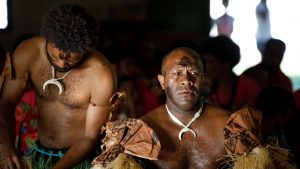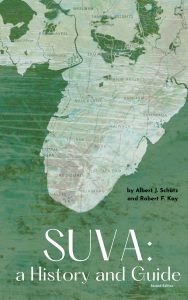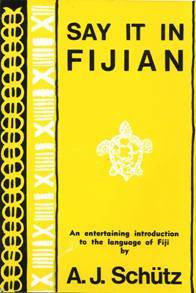Fijian pronunciation
Editor’s Note: Vinaka to the late Dr. Albert Schutz author of Say it in Fijian and Discovering Fijian for providing FijiGuide with this primer on pronunciation. Be sure and read our list of useful Fijian words and phrases.
Unlike English spelling, which is riddled with exceptions, Fijian spelling is regular. This quality gives you a good chance of pronouncing words correctly when you read them.
Vowels
If you’re told that Fijian vowels are similar to those in Latin or Spanish, you’re out of luck if you don’t know those languages. So just to make sure, use the following rules, which have no exceptions.
a as in father
e as in bait, but without the glide at the end.
i as in beat, but without the glide at the end.
o as in boat, but without the glide at the end.
u as in boot, but without the glide at the end.
If a vowel has a line over it, this means that it lasts longer. Long vowels are always accented, no matter what their position. (Unfortunately, Fijian’s official writing system doesn’t mark long vowels. But they are marked on the headwords in a dictionary.
Diphthongs
Certain combinations of vowels act as units:
ai au ei eu oi ou iu
This means that no matter where these vowel clusters appear in a word, the accent is on the first vowel. We’ll say more about this topic in the section on accent below.
Consonants
Most Fijian and English consonant letters are pronounced similarly. The following five are the exceptions:
b, which represents mb, as in member.
d, which represents nd, as in Monday.
q, which represents ng+g, as in finger.
g, which represents ng, as in singer.
c, which represents th, as in father.
Accent
Accent—that is, making a syllable more prominent than those around it—is predictable only for short words. For words with two or three short syllables, the accent is always on the second-to-last syllable. In the following examples, the vowel of the accented syllable is in boldface:
dua one
mata eye, face
tolu three
totoka beautiful
Syllables with a long vowel or a diphthong are accented, no matter what their position:
vā four rai seen
kilā know it mā.rau happy
In terms of accent, longer words and phrases are made up of short units, called measures. You can see that the word mā.rau is divided into two measures, and the boundary is marked by a full stop. It’s not part of the usual writing system, but it’ll help you find the accents in longer words. For example:
bulu.makau cattle
dai.dai today
bā.ravi coast
leka.leka short
posi.tō.vesi post office
ivā.vā shoes
As you can see from the vowels in boldface, each diphthong, long vowel, and second-to-last short vowel in a measure is accented. Moreover, the last measure in a word is given slightly more emphasis.
HOW THE LANGUAGE WORKS
Particles and. markers, the grammatical workers
Most of us who have studied a classical language — or perhaps French, German, or Spanish — are only too familiar with paradigms. Aside from their real function, which is to show a related set of words, these paradigms represented an array of items to be memorized. ‘Learn the paradigms, and learn the language’ seemed to be the idea.
Cargill, who was trained in classical languages, arrived in Fiji with the notion of paradigms firmly implanted in his mind. It was the classical mold, and he tried to bend Fijian so it would fit. Naturally, the language resisted, and the results of Cargill’s efforts look forced.
The following is from his 1839 manuscript grammar (of the language of Lakeba Island) and is an example of the declension of a common noun:
A vale, the house.
****
Singular
Nominative A vale the house
Genitive Ni vale of the house
Dative Ki na vale to the house
Accusative A vale the house
Vocative Vale house
Ablative I na vale in the house
Ablative Mai na vale from the house
Cargill continued with dual (that is, two) and plural, and altogether gave eight pages of examples of the declension of nouns. Actually it is not useful to decline nouns or conjugate verbs in Fijian, for words do not change as they do.in, say, Latin or Greek.
Most of the grammatical work is done by a group of particles or markers. These particles, along with other grammatical words like pronouns, make up the skeleton of a Fijian sentence. It is into this framework that the Teal’ words fit.
Cargill continued with dual (that is, two) and plural, and altogether gave eight pages of examples of the declension of nouns. Actually it is not useful to decline nouns or conjugate verbs in Fijian, for words do not change as they do.in, say, Latin or Greek.
Most of the grammatical work is done by a group of particles or markers. These particles, along with other grammatical words like pronouns, make up the skeleton of a Fijian sentence. It is into this framework that the Teal’ words fit.
Nouns, Verbs and. Adjectives
Now to pass from generalities to details. The Fijian language is, and must be divided into ten parts of speech. . . . G. A. F. W. Beauclerc
The Fijian Language, 1910
Why must it be so divided? No reason at all. (Beauclerc was by the way, the well-intentioned amateur who thought that Fijian tamata, meaning ‘person,* was derived from Adam, and koll, meaning ‘dog’ from collie)
The classical grammarians divided words into parts of speech that behaved differently. For instance, nouns took case endings, and verbs were inflected for person, number, and tense.
Without such endings in Fijian, the grammarians were hard-pressed to make such classifications. For example, note the Fijian word leva. It is translated as ‘big’ and thus sounds to us like an adjective:
na gone levu the big child
the child big
But it can also serve as a verb:
Sa levu na gone The child is big or
is big the child There are many children.
We call levu a verb in this construction because it fits into the same slot as other verbs, as in the sentence:
Sa lagi na gone The child is crying.
is cry the child
In still another construction, levu is a noun:
na kena * levu its size (‘bigness’)
the its size
Thus, for many Fijian words, their accompanying particles and their place in the sentence determine whether we think of them as nouns, verbs, or adjectives.
Word, order
The first phrase in the preceding section shows a. striking feature of Fijian word order — that of modifiers:
na gone levu the big child
the child big
Modifiers follow the words they modify. Logical? It is most likely that logical word order is what we’re used to. This is why the sentences you have seen so far may have seemed strange.
For Fijian, a verb phrase followed by a noun phrase is normal:
Sa levu na gone The child is big
Sa cici na gone The child is running
Verb phrase Noun phrase
Another common sentence type is called ‘equational’. It corresponds to English sentences with ‘to be’, but without a counterpart to the English verb. Fijian’s lack of a direct translation of ‘to be’ (and incidentally, ‘to have’) drove many an early grammarian to distraction, and some of them went through great linguistic contortions to prove its existence — but without real success.
Why is “to be’ needed? Fijian works quite well without it. In equational sentences, two noun phrases are understood to be equivalent:
Na qase ni vuli ko Seru Seru is the teacher,
the teacher (=) Seru
E dua na mata ni vatuia ko koya He is a herald.
A herald (—) he
These examples show that word order is not a matter of logic, but only of convention.
Pronouns
So far, the sentences illustrated here have used only a few simple pronouns — an meaning T; and ko and kofit ‘you’. But the remainder of Fijian pronouns make much finer distinctions. Counting the possessives, they total about 90 in number, proving a grammarian’s delight and a language-learner’s curse for over a century.
Cargill devoted fifty-three pages of his manuscript grammar to pronouns and possessives, and early in the present century, an amateur philologist (more eloquently than astutely) exclaimed:
The pronouns are so extensive, so elaborately arranged and form such a perfect system, that they first cause a certain class of persons to stare aghast and give up the attempt to learn them, and secondly when mastered (by the other class) they make the study of the rest of the language a mere bagatelle.
G. A. F. W. Beauclerc
The Fijian Language, 1910
This is, of course, complete nonsense. One (of the proper class!) could probably memorize the forms over the weekend and still find on Monday morning that learning the rest of the language was something more than a ‘mere bagatelle’.
There are two main differences between Fijian and English pronouns. First, the Fijian system distinguishes between not only singular and plural, but also has separate form for dual (that is, two) and trial (three, or a few). Note the various ways of saying ‘you’:
ko you (singular)
ko dtau you (dual)
ko dou you (trial)
ko n~i you (plural)
The second difference concerns the various meanings of ‘we’ — that is, whether or not the person spoken to is included. The distinction is called inclusive-exclusive, and this system, combined with the various numbers, produces six ways of translating ‘we’ into Fijian:
keirau (he and I)
keiiou (they and I)
keimami (they and I)
daru (you and I)
datou (you and he and I)
da (they and you and I)
Confusing inclusive and exclusive results in misunderstandings. The story is told of one of the early missionaries trying out his newly-acquired skill in the language with a prayer, in which he meant to say something like ‘Lord, we are sinners . . But when he used the inclusive form, the Fijian listeners thought it strange indeed that the Europeans’ God be included as a sinner.
An unusual gender system
To most nineteenth-century grammarians (and some current ones), gender was a system that languages used to distinguish among masculine, feminine, and neuter objects. Not being able to find this system in Fijian, they still tried to discuss gender by citing forms for “rooster’, ‘hen’, and other pairs of animals, all of which distinguish sex by adding tagane ‘male’ or yalewa ‘female’ to the noun. This has little to do with grammar.
But there is a gender system in Fijian, and one might call it ‘sexless’, since the customary classification won’t work. The following are examples of possessed items. Note the different ways of saying ‘my’:
Uga hand bia beer
ligaqu my hand mequ bia my beer
ika fish vale house
kequ ika my fish noqu vale my house
The key to the word classes lies in the semantic qualities of the things possessed:
- Body parts and kinship terms
- Edible items
- Drinkable items
- All other possessable items
Sometimes there can be crossing over from one class to another. For example, dalo (taro) is normally to be eaten, and is therefore used with kequ or qau. But one might say noqu dalo if the taro were meant specifically to be sold.
Changes in the language
Amatida mati satana volo
Amatida mati ata kerei ttfolu
Oloki ga sosea noloki gasamene
Ku tana vul amatida matedo geca okeini
LIV, 1969
Recognize it? Perhaps not at first. But it’s not really Fijian. Pronounce it fast, according to the rules listed at the beginning, and ignore the word divisions:
Humpty Dumpty sat on a wall . . .
This ‘borrowing’ was done as language play — a sort of pun — but Fijian has a great many words that actually have been borrowed from English. One of the first found in early manuscripts is ‘tobacco’, written by a Frenchman in the 1820s as tabaka (and as such could possibly be from French) and now regularly as tavako. It didn’t take long for other words to be borrowed. The first printed Fijian was partially a translation of a simplified catechism, and the nature of religious translation usually makes it necessary to borrow words for names and other concepts not in the culture.
Cargill and Cross used A lama, Jihova and Jisu Karaisi for proper names, and heli and hevani for other nouns. The last one is one of the few borrowed in the true sense, for it was ‘given back’ and replaced by lomalagi, which first meant ‘sky’.
By the time Cargill completed his glossary of Lakeba words (1839), he included some secular terms:
pent penny penikau pencil (literally, wooden pen)
peni pen si pi sheep
vinika vinegar
It would be difficult to say how many English words have now been adopted by Fijian. At first the translators worried that the process would go on unchecked; thus Cargill fretted about Tonga:
Another practice prevails in that group which if persisted in will ultimately destroy the simplicity of the language … I allude to the immense number of English words which are introduced into the language. Such is the number of foreign words which are constantly introduced, that when a new book is printed it is impossible for a native to understand it without an English interpreter . . .
Cargill’s fears were unfounded, for all languages borrow freely when there is need to do so. But do borrowed words remain unchanged? Far from it, when the donor and the borrower are as different as English and Fijian.
Two characteristics of Fijian that have the most effect on the forms of the borrowed words are these: first, each Fijian syllable ends in a vowel; and second, except for b, d, q, and dr, there are no consonant clusters. These conditions result in Fijians adding vowel to the end of a word, and either simplifying clusters, or separating the consonants with vowels. Sometimes the results look rather unlike the donor words. Can you identify the following?
1. alakaolo 7. id ini
2. ana 8. jiokarafi
3. baisikeli 9. kaliko
4. biriki 10. savumarini
5. cioloji 11. sipiriti
6. fiva 12. vinivo
The English donors are 1) alcohol, 2) hour, 3) bicycle, 4) brick, 5) theology, 6) fever, 7) engine, 8) geography, 9) calico, 10) submarine, 11) spirits, 12) pinafore.
Sometimes, the borrowed words are cut into pieces because of Fijian grammar. ‘Napkin’ (meaning a baby’s garment) was borrowed as na pikini, because in Fijian na means ‘the’.
A different kind of switch took place with ‘bee’ and ‘honey’. ‘Bee’ became oni (that is, honey), and ‘honey’ is translated as de ni oni ‘excrement of the bee’.
The process has by no means stopped. Modern newspapers use words like these: niukitia (nuclear), daqari (dungarees), basikete polo (basketball), and bdmeti (barmaid). What better signs that the language is capable of changing with the times?
Further reading
In contrast to the light treatment here, there are a number of more thorough studies of Fijian — different views from different angles.
Na i Fosavosa Vakaviti e Sa (Anare Raiwalui, Oxford, 1954) is a collection of idioms, or proverbs, that afford a closer look at Fijian used as art or metaphor.
Fijian Grammar (G. B. Milner, Fiji Government Press, 1956) is the most comprehensive grammatical study available.
A New Fijian Dictionary (A. Capell, Government Printer Suva 1968 (Third edition), the direct descendant of Hazlewood’s 1850 work, is an essential tool for the serious student or translator.
Spoken Fijian (Albert J. Schutz and Rusiate T. Komaitai, University of Hawaii Press, 1971) is a text for language learners, based on the materials that the authors developed for use by the Peace Corps.
The Languages of Fiji (Albert J. Schutz, Oxford, 1972) is a history and review of what has been written about Fijian, from the early nineteenth century to the present.
©2022 Dr. Albert J. Schütz
Top Shot Courtesy Rob Rickman (via Talanoa Tours)












































The “further reading” on this page is extremely helpful.
The “Fijian-English Dictionary” by Ronald Gatty, is also a really good resource.
Additionally, does anyone know of a free, online way to access the “Fijian Grammar (G. B. Milner, Fiji Government Press, 1956)”?
Thanks.